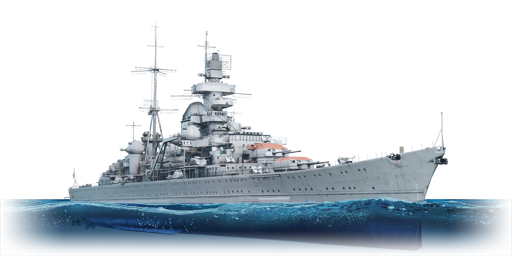The Prinz Eugen was the third of the Admiral Hipper-class heavy cruisers and the last to be completed by the Kriegsmarine. She was ordered from the Krupp Germaniawerft shipyard in Kiel and was laid down on 23 April 1936 as part of the German rearmament programme following the Anglo-German Naval Agreement a year prior, and was later launched on 22 August 1938.
After being commissioned in 1940 and patrolling around the Atlantic alongside the battleship Bismarck in early May 1941, Prinz Eugen would take part in her most famous engagements in the Battle of the Denmark Strait later that month, in which the pair managed to sink the British flagship HMS Hood and damage the battleship Prince of Wales. However, Eugen suffered a fuel tank leak and was forced to part ways with Bismarck, leaving the latter to her demise a few days later. After emergency repairs and problems with her engines and turbine, Prinz Eugen was ordered to be docked in Brest, occupied France, for extensive repair. After spending half a year in Brest and being the target of frequent air raids by the RAF, Prinz Eugen, along with battleships Scharnhorst and Gneisenau, was ordered to break through the English Channel in January 1942. The next month, Eugen's stern was struck by a torpedo from the submarine HMS Trident, resulting in extensive damage to the rudder. After completing her repair in 1943, Prinz Eugen was sent to the Baltic Sea to provide fire support for the retreating German army on the Eastern Front, which she did until the German capitulation in 1945. She and Nürnberg were the only German bluewater warships to survive the war intact.
After the war, Prinz Eugen was later awarded to the United States as reparation. The US Navy subsequently conducted extensive examinations on various German machinery. After which, Prinz Eugen's career literally ended with a bang when she was used as one of the targets for the Operation Crossroads nuclear tests in 1946.
Introduced in Update 1.95 "Northern Wind", the Prinz Eugen is perhaps one of the most famous cruisers of World War II. Compared to her sister ship, Admiral Hipper, Eugen is in her final 1945 configuration with a substantial increase in AA firepower and crew count. This is effectively a double-edged sword; on one hand, she is more survivable than her sister ship and better protected against aircraft, while on the other hand, her large amounts of AA mounts mean that she will frequently catch fire whenever hit. Aside from this, Eugen is largely the same as Hipper in playstyle, being an all-around heavy cruiser with a particular focus on her high-velocity 8-inch guns, capable of engaging any targets she could face.









 2 x (450 / 600) %
2 x (450 / 600) % 
 2 x 190 %
2 x 190 % 
